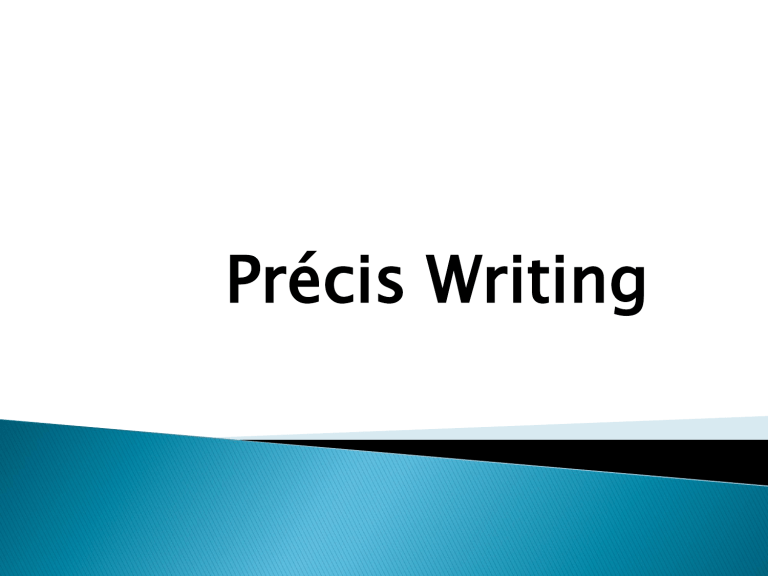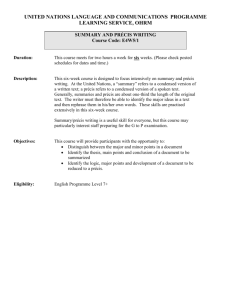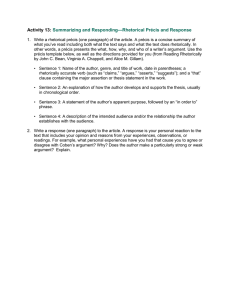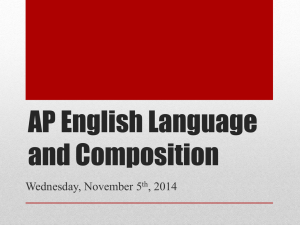
Précis Writing • • • • • • • • What is an Essay? Essay Format How to write an Essay Essay Types – Descriptive Essay – Definition Essay – Compare and Contrast Essay – Cause and Effect Essay – Narrative Essay – Argumentative Essay – Critical Essay – Evaluation Essay – Analysis Essay – Reflective Essay – Expository Essay Cohesion and Coherence in Essay Scratching outline for an Essay Topic Outline Sentence Outline A précis is a clear concise, orderly summary of the contents of a piece of writing. A précis is a formal summary of a non-fictional work. Précis are used to present the ideas in the original work as a thumbnail sketch. However, the précis must be ◦ objective (That means no personal interpretation) ◦ complete (All major ideas, significant arguments, support) ◦ concise (one-quarter to one-fifth the size of the original) Précis are used in scholarly endeavors as ◦ part of the research process ◦ means to prevent plagiarism The précis ◦ is a type of summarizing that insists on an exact reproduction of the logic, organization, and emphasis of the original texts. ◦ details the relative order, proportions, and relationships of the original parts of a text. An effective précis ◦ retains the logic, development, and argument of the original in much shorter form. ◦ is useful when you are dealing with lengthy passages that demand careful attention to the logic and organization of an argument. that is a concentration of ideas from the original piece of writing that is boiled down so that only the essence of the original remains To shorten or summarize: rules and regulations newspaper articles • legal papers and laws, • announcements, • directions, • business letters, • speeches and conversations etc A paraphrase ◦ ◦ says in different and simpler words exactly what the original passage has to say. may be as long as the passage itself. A précis ◦ ◦ rarely is more than one-third the length of the original selection and may be only one-fourth as long. gives only the “heart” of a passage. It omits repetition and such details as examples, illustrations, and adjectives unless they are of unusual importance. • A précis is written – entirely in the words of the person writing it, not in the words of the original selection. • Tip: Avoid the temptation to lift long phrases and whole sentences from the original. – from the point of view of the author whose work is being summarized. • Do not begin with such expressions as “This author says…” or “The paragraph means…”. • Begin as though you were summarizing. Writing is only half of the challenge. The most important task is to read and fully understand the text. Often, we understand information we can relate to, or fit into previously-known frames of reference, values, ideas. However, sources often refute, expand, challenge us to think more deeply about the subject. A précis does not serve to argue against, to point out errors or logical fallacies, or to judge the author’s ideas. Therefore, it is the thinking before the writing that determines a worthy précis. This assignment is not easy! However, it does bring benefits. Upon completion of the précis, especially if done well, you will never, ever forget the argument, the examples, and the development of the article. You will also find that skills developed in précis writing establish and hone foundational skills required for both educational and professional success. ◦ ◦ ◦ ◦ analysis synthesis comparison other key higher-order thinking skills To compress, distill, and clarify a lengthy passage, article, or book, while retaining important concepts, key words, and important data To remove superfluous information yet retain the core essence of the work To define, in brief, any key terms To give a brief description of methods and approaches used by the researchers To state the importance of the research or piece of writing ◦ Why was it important to conduct this research or write on this topic? Underline, highlight, or circle key sentences, phrases, and words. Read each paragraph as a unit of thought. Use a dictionary for words that seem important or those that you do not understand. As you discover them, summarize main points in a few words. Decide if the content is based on opinion, evidence, and/or logic and why that can be important. Note: The italicized skills are not used when preparing to write a précis. Think about the subject-audience-contextpurpose relationship. Look for evidence, logical analysis, reasoning. Think about your biases for and against the ideas presented.* Evaluate your reactions to the material.* Annotate: Make notes in the margins. * Note: In précis writing, you will have to disregard these reactions. Record reactions*, questions, and understandings of the reading. Organize text for reviewing, studying, or writing by adding numbers to marginal notes. Isolate key terms and phrases. Write them in the margins. Write notes on key words, phrases, or sentences. These writings can comment*, question, evaluate*, define, relate*, challenge*. * Note: The italicized skills are not used when preparing to write a précis. Use Active Reading skills as you comb the article many times to ferret out its gist and significant details. 1. Highlight the work as you read. ◦ ◦ ◦ Locate the thesis statement and its sub-arguments. For each point, find the specific, supporting evidence used by the author. Write key words and numbers in the margin to outline the work. Read the work again, adding and discarding marginal notes. 2. ◦ ◦ ◦ One of the first (if not the first) difficulties to overcome in writing a précis is getting the facts straight. You should not list any statements unsupported by the text. Make sure to extract only factually correct information. 3. Another difficulty is putting the material into your own words. ◦ ◦ After reading the text three times, put the work aside; then begin writing. This will force you to use your own words without the temptation of borrowing directly from the original. Check the piece for accuracy. 4. Writing in your own words, begin the précis with a statement that encompasses the entire argument. Remember that the précis takes the point-of-view of the original writer. If the original is written in the first person, reflect this in the précis. ◦ ◦ Not “In the Declaration of Independence, Jefferson maintains…” But “An essential connection binds between how we are governed and…” 5. Present the logical progression (the development) of the argument with its component parts in your own words. ◦ 6. Use your marginal numbers and key words as guides. Simplify. ◦ ◦ ◦ Use words to replace phrases, and use phrases to replace clauses. Discard unimportant ideas and illustrations. Use simple figures of speech. 7. Reduce the article to one-fifth to one-third of its original length, omitting nothing from the essential argument. ◦ ◦ ◦ ◦ Although you should be as brief as possible, guard against being so condensed that you obscure the point of passage. Nothing should be said more than once. Check your draft for expression errors, repetition or vague phrasing; then write a smoother final version. This is, in reality, this is the key to the whole enterprise! 8. Type the précis, beginning with your abstraction of the central, informing idea of the article. Having understood and written the central idea, present the essential argument in as cogent manner as possible. ◦ Clue: Once you have assimilated the article through the illustrations and examples the writer uses to make his/her abstract ideas concrete, you do not have to include these illustrations and examples in your précis! Do not copy even one single sentence from the article! You may use the author’s key words and phrases (quoted) only to present technical terms central to the author’s arguments or support So, paraphrase, paraphrase, paraphrase… unless there is really, truly, no better way to express a concept than by using the author’s words. ◦ You must be certain that no other statement can possibly be as pithy or as precise so as to present this idea. When finished, the précis should clearly state the… ◦ ◦ ◦ ◦ Position studied/argued/discussed Focus or methods used to prove position Ideas as understood at a deep level Significance/Importance of this concept or set of concepts Check the draft for expression errors, repetition or vague phrasing; then write a smoother final version. Are the opening sentences brief and to the point? Which is best? Which opening sentence tends to show best what the passage expresses? Does the sentence following the opening sentence amplify the essentials shown in the opening sentence? Which précis clarifies the author’s best thoughts? Have additional thoughts been added? Is the précis clear to one who has not seen the original source? Did you retain the logical order and development of these thoughts? Did you emphasize the dominant thought or erroneously emphasize a minor thought? Did you omit any necessary facts? names? dates? places? Is your précis clear to one who has not seen the original? Are your sentences clear and well-constructed? Did you use third person and the past tense? Did you punctuate and spell correctly? Did you make any grammatical or rhetorical errors? 1. 2. Read your first copy through carefully. Condense wherever you can, substituting single words for phrases and phrases for longer clauses. 3. Use only simple figures of speech. 4. Clearly and concisely express the essential points. 5. 6. 7. Reduce verbiage while still making the point and retaining some of the flavor and spirit of the original. Be fair to the sentiments expressed, even if you don't agree with them. Rewrite neatly. and be more specific Your first sentence in the précis should have: the name of author, the genre & title of the work, date in parentheses, an active verb (such as "assert" "argue" "suggest" "imply" "claim“) and a THAT clause which contains the thesis statement of the work. This sentence is the who & the what of the original work. Gregory’s novel, The Other Boleyn Girl (2001), implies that ambition possesses the power to corrupt and dispense true gratification, filling the heart solely with desire infused with greed and the ravenous hunger to reign. Phillipa Notice the who and what is clearly defined in the first précis sentence. an explanation of how the author develops and/or supports the thesis, This is usually done in chronological order. Gregory develops this assertion through vivid description of life in the Tudor court and examination of cut-throat antics of a ruthless family-members of whom will execute to attain absolute power. A statement of the author’s apparent purpose, followed by an "in order" phrase. Gregory’s purpose of elaborating on ambition is to depict the outlandish lengths one will embark in order to fill a selfish void within one’s greedy and desperate soul. Sentence 4: A description of the intended audience and/or the relationship the author establishes with the audience. Gregory engages the average woman through the themes of scandal, conniving competition, and passionate lust, all of which evokes every woman’s desire to be a queen. Study each paragraph, read it to understand the main points then summarize the main points in your own words A précis retells the highlights so a reader will know main sections of the original Writing a Précis Précis is a clear, concise, orderly summary of the contents of a piece of writing. A précis has only the essential details & they must be correct & accurate • A four page article will become a one page précis All words in the précis must be original…A few quotes are acceptable. A précis is a condensed restatement of an article, roughly ¼ the length of the original or less. In contrast to a summary, a précis should preserve the article’s logic and emphases, and include main examples where relevant. A précis of a primary-literature scientific paper should follow the standard format: background/hypothesis, methods, results, conclusion. The précis should be written from the original author’s point of view, without editorializing. 1. Start your précis by creating context (setting) and stating the main idea of the pieces. Then you should begin presenting the method that the original author/report used 2. Always state the name of the article/document, the author and the source(is it from a magazine, book, encyclopedia, etc.) 3. Do not use the word “ in this article.” Use the style “Crane argues that the most significant contribution of the Czechs was…” 4. When writing about history, use the past tense. 5. Do not use abbreviations or contractions 6. When looking are primary sources, you should make not of the origin, purpose, value and limitations of the document. 7. Count your “ands” 8. Avoid words like big, good, bad, little and a lot, also do not use cliché. 9. Titles of texts should be put in italics or underlined. 10. Make sure there is a clear “impact to the organization” mentioned. For example, if your are summarizing a new tax rule, mention what will be the consequence of it to your organization (that is what your manager will be most interested in) 11. Give a recommendation s required 12. Run a spell check 1 - Read the article carefully all the way through 2 - Consider the main points 3 - Go over the article again, jotting down the main points (NOT whole sentences) 4 - Join together the points, in order, in a logical narrative 5 - Edit to place proper stress on main points, cut out extra details






